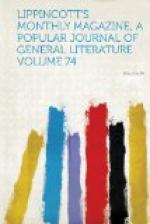The matter of this volume was collected during a fixed residence of several years in one of the central provinces of France. No doubt Mr. Hamerton had a previous acquaintance with the country and with its language far exceeding that of the mere tourist, and his wife, it appears, is a Frenchwoman, the daughter of an ex-prefet. But he makes few allusions to any former experiences, and draws no comparisons between the conditions of life or the characteristics of the people in different provinces. This is perhaps to be considered a defect in the book, though it might not have possessed the same attractiveness had its scope been wider. It is an advantage, too, that the locality was not one which excites curiosity by its strongly marked features or abnormal types. Travelers often seem to imagine that they have only to tell us about Brittany or Gascony to win our interest, whereas it is precisely such regions that have the least novelty for us, just as the scenery of the Scottish Highlands has been made more familiar to Americans than that of almost any other part of Britain. Mr. Hamerton’s house, as he gives us clearly to understand, though he suppresses names, was in the neighborhood of Autun. The situation was a strictly rural one, but with easy access to the town and the feasibility of reaching Paris, Lyons or Geneva in a night’s journey by rail. It had, he writes, “one very valuable characteristic in great perfection—namely, variety. There was nothing in it very striking




